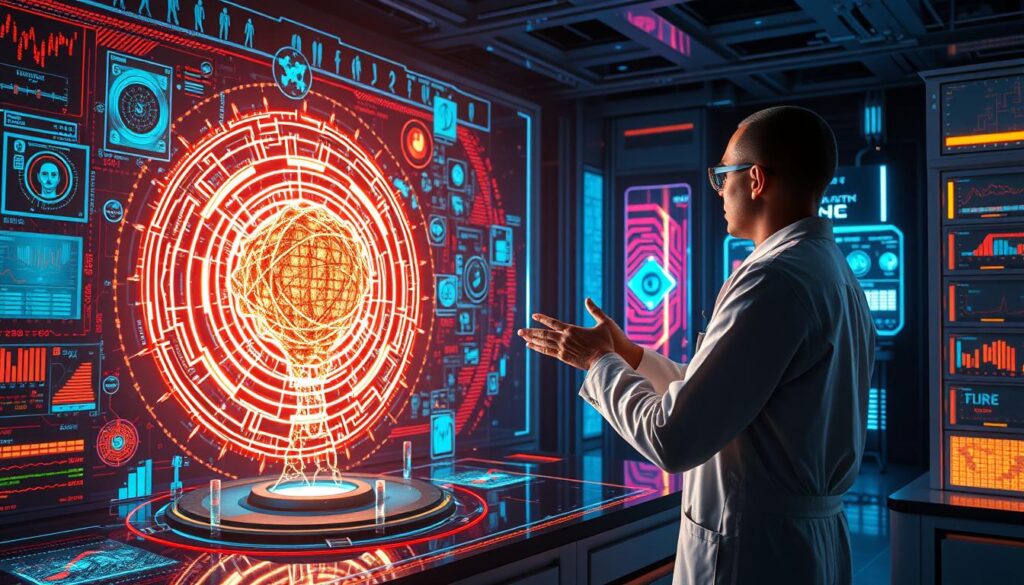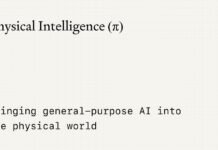Did you know about 25% of people can now make their own AI characters or apps? This is thanks to the rise in easy-to-use AI tech1. This shows a big change in how AI is made, making it more for individuals than just big companies.
New tools and platforms are coming out, making it easier for anyone to start making AI. Now, both newbies and experts have resources to help them. This means anyone with the right skills can create an AI. This article will cover the basics of making an AI, including tools, skills, and what it really takes.
Key Takeaways
- The ability to create an AI is increasingly accessible to individuals.
- Various user-friendly tools and platforms facilitate personal AI creation.
- Understanding foundational AI concepts is essential for successful development.
- Individual capabilities can make significant contributions to AI projects.
- Misinformation about AI development can hinder personal involvement.
- Getting started requires careful planning and resource gathering.
Understanding Artificial Intelligence
Artificial Intelligence (AI) is a technology that lets computers and machines think like humans. They can learn, understand, solve problems, make decisions, be creative, and act on their own2. To really get AI, we need to know the different types it comes in. There are mainly three kinds:
What is Artificial Intelligence?
AI is divided into three main types. Narrow AI (ANI) is great at doing one thing, like helping with virtual assistants (e.g., Alexa and Siri)3. General AI (AGI) is the dream where machines can do anything humans can3. Super AI (ASI) is even more advanced, where machines are smarter than humans in every way3.
Types of Artificial Intelligence
AI is growing fast and is now used in many fields. Knowing AI is key for success in today’s world4. Most AI we see today is Narrow AI. But, scientists are still working on General AI and Superintelligent AI4.
Importance of AI in Today’s World
AI could add $15.7 trillion to the world’s economy by 2035. The U.S. and China will likely see the biggest benefits, making up almost 70% of the gain3. To learn AI, you need to know programming and math. There are many online courses to help you start4.
Getting involved in AI projects and joining online AI groups can also help. These activities let you learn and work with others4. Generative AI is especially exciting. It can make new content like text, images, and videos2.
Can a person create an AI?

The world of artificial intelligence is changing fast. With the right tools and knowledge, anyone can try their hand at AI. It’s not just for big tech companies or coding experts anymore. Now, people from all walks of life can create AI that meets their needs.
Individual Capabilities in AI Development
Many think you need to be a coding master to make AI. This idea keeps many from trying, thanks to myths about AI creation. But, places like Coursera and Udemy offer courses that teach AI basics5. Tools like Python and TensorFlow make it easier for beginners to learn and improve.
Myths and Realities About Individuals Creating AI
Some believe only those with lots of money can work on AI. But, the best AI projects often come from teams with different skills. Online groups and platforms help people work together, sharing knowledge and working towards success. This shows that anyone can help shape the future of AI.
Essential Steps to Building Your Own AI
Creating an AI solution needs a clear plan. The key steps involve identifying problems, gathering data, and choosing the right tools. This starts with knowing what problem you want to solve.
Identifying the Problem to Solve
Understanding the problem is key. Knowing what issue to tackle guides all your work. This first step helps set clear goals and the project’s scope.
Gathering High-Quality Data
Getting good data is vital. Quality data is crucial for AI models to work well. Using careful data collection methods ensures the data is accurate and useful. For instance, AI helps machines make smart choices by processing data well6.
Choosing the Right Tools and Technologies
Picking the right AI tools is important. There are many options, from easy-to-use platforms to complex coding environments. It’s crucial to choose tools that match your skills for a smooth project. The AI software market is growing fast, expected to hit $126 billion by 20257. This shows the need for good AI tools.
Methods for Creating AI Models
There are many ways to make AI models, each suited for different skills and needs. Knowing these methods is key for those wanting to work on AI projects.
No-Code/Low-Code Platforms
No-code AI platforms let users with little coding know-how build models easily. They offer a simple way for data analysts to make AI without coding headaches8. Users just drag and drop parts to make their models, making it great for fast projects.
Automated Machine Learning (AutoML)
AutoML is a strong method in AI making, automating many steps in model creation. It handles things like feature engineering and hyperparameter tuning, making the process smoother and easier910. Even with AutoML, knowing the basics is still needed for the best results.
Traditional Programming Approaches
Traditional programming needs a hands-on approach, with developers coding specific algorithms. It offers more control and flexibility, allowing for detailed AI designs for unique problems. But, it requires deep knowledge in machine learning and programming languages like Python or R108. For those skilled, it can create powerful AI models by using complex data.
Data Preparation for AI Development
Data preparation is key in AI system development. It includes cleaning, organizing, and categorizing data to improve AI data quality. By classifying data correctly, organizations can handle it better. Cleaning data well is crucial for AI models to work well under different conditions11.
Cleaning and Organizing Data
The first step in AI data prep is cleaning and organizing. It removes errors and fills in missing data for thorough analysis. Visualizing data helps spot problems that could harm AI model performance. Normalizing data makes models more consistent by giving each feature equal weight11.
Importance of Data Quality
Data quality is crucial for AI to learn and predict well. Good data makes AI reliable and boosts predictive success. Checking data consistency keeps it organized and points out issues11. Also, poor data quality can increase costs due to extra work and data needs12.
Types of Data to Consider
When getting data ready for AI, consider different types. Structured data is easy to search, while unstructured data needs more work. Data-driven companies get better customer experiences and decisions with good data handling11. Transforming and engineering data well improves AI performance11.
Training and Deploying Your AI Model
Implementing AI technologies requires a careful approach to AI model training and model deployment. These steps are key to making sure the AI system works well in real-world settings.
Understanding Model Training
AI model training means using data to teach algorithms. This process helps the system learn to answer questions accurately13. To train well, you need lots of good data. The quality of the data greatly affects how well the model performs13.
Organizations need to know what problems they want to solve. They also need to find the right data for training14.
Training time can vary a lot. Some studies show custom models are much faster and cheaper than big pre-made models15. For example, training a model to detect objects cost about $60 and took just three hours15.
Performance Evaluation and Monitoring
After training, checking how well the model works is crucial. This ensures it meets the needed standards. Keeping an eye on the model lets you tweak it based on how it’s doing13.
This checking is a big part of making sure the model works right in real life14.
Using tools like Google’s Vertex AI helps manage data quality during training and deployment15. These tools help make sure the model stays effective by regularly checking its performance and making adjustments as needed.
Conclusion
Creating AI on your own is not only possible but also encouraged by today’s technology. You can start by learning the basics of AI and finding a problem to solve. This way, you can begin your AI creation journey.
There’s a lot of room for innovation and success in AI development. With tasks in the U.S. economy facing automation risks, up to 30% of work hours could change by 203016.
AI is also expected to create 97 million new jobs by 2025. However, there’s a concern about skill gaps. This highlights the importance of proper data preparation and the right methods for building AI insights16.
The future of AI looks promising, with tools that could change content creation. It’s crucial for aspiring developers to stay updated and flexible17.
With ongoing advancements, there’s a lot of opportunity for those willing to learn about AI. By tackling challenges like diversity in AI training data, you can make a big impact in the AI field18.
FAQ
Can an individual really create an AI?
What are no-code/low-code platforms and how do they help in AI creation?
What kind of data is essential for training an AI model?
What are the most common types of AI?
How can individuals evaluate the performance of their AI models?
What myths exist about individual AI development?
What are the steps involved in building AI from scratch?
Why is data preparation crucial in AI development?
After training an AI model, what should be done next?
Source Links
- Create Your Own Custom AI With AI Studio | Meta
- What Is Artificial Intelligence (AI)? | IBM
- What is Artificial Intelligence? How AI Works & Key Concepts
- Learn AI: Guide to Understanding Artificial Intelligence | Atlassian
- Can a Non-Technical Person Learn Machine Learning & AI Like a Professional? Absolutely Yes!
- How to create an AI
- How To Build AI Software: A Manual For Founders | Uptech
- A Complete Guide on How to Create an AI
- 3 Ways to Build Your Own AI Model
- How to Create AI: A Step-by-Step Guide
- A Guide to Preparing Organizational Data for AI | Core BTS
- How to Create an AI Model? – Software Mind
- What is AI model training and why is it important?
- How Does AI Model Training Work?
- Training Your Own AI Model Is Not As Hard As You (Probably) Think
- 14 Dangers of Artificial Intelligence (AI) | Built In
- AI-Driven Content Creation: Benefits and Challenges
- Will Artificial Intelligence Surpass Human Intelligence?







